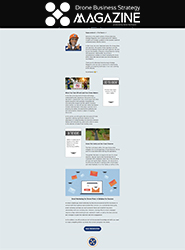
In the world of drone operations, aeronautical decision making (ADM) takes center stage as drone pilots navigate the skies, ensuring the success and safety of their missions. Just like traditional pilots, drone operators need to gather crucial information and make informed choices to mitigate risks and achieve their objectives. One fundamental element of ADM is the establishment of personal weather minimums, a strategic approach that empowers drone pilots to make well-informed decisions and prioritize safety above all else.
In this article, we delve into the concept of personal weather minimums and explore a cutting-edge tool, weather cameras, that is revolutionizing the drone flight risk strategy process.
Setting Your Personal Weather Minimums
Much like a captain navigating a ship through stormy seas, a drone pilot must chart a course that accounts for ever-changing weather conditions. These predefined conditions are known as personal weather minimums – a set of guidelines tailored to each pilot’s unique skill set, experience, and the specific operational requirements of their drone. This personalized approach ensures that every flight is grounded in a thorough assessment of the pilot’s capabilities and the prevailing environmental conditions.
Creating your personal minimums is not a last-minute task; it requires careful consideration well in advance of any flight. Drawing from established procedures, rules, and criteria, drone pilots can craft a framework that helps them determine when it’s safe to take off and when it’s best to postpone or adjust the mission. Consulting with experienced professionals, such as flight instructors, can provide invaluable insights and aid in performing a comprehensive self-assessment.
Key Steps in Developing Drone Pilot Personal Minimums
- Advance Planning: Establish personal minimums ahead of time, considering factors like visibility, wind speed, and temperature.
- Expert Consultation: Seek guidance from flight instructors or seasoned pilots to ensure a comprehensive self-evaluation.
- Documentation: Write down your personal minimums and keep them accessible for easy reference.
- Regular Review: Continuously assess and refine your personal minimums to reflect changes in your skills and operational needs.
- Vigilant Application: Consistently apply your personal minimums, as they can play a crucial role in preserving the safety of yourself, your equipment, and bystanders.
Integration of Personal Minimums and ADM
Personal minimums complement ADM by providing drone pilots with a structured framework to assess risks before embarking on a flight. The PAVE acronym – Pilot, Aircraft, enVironment, and External Pressures – further enhances the risk evaluation process. By considering questions like, “Am I well-rested and in the right frame of mind?” or “Is my drone equipped to handle the weather conditions?” drone operators can make well-informed decisions that account for both internal and external factors.
Weather: The Game-Changer
Weather plays a pivotal role in drone operations, often posing challenges that require careful consideration. While local flights near airports may benefit from readily available weather information, more remote regions, like Alaska, present unique challenges due to limited data accessibility. Enter the Federal Aviation Administration’s (FAA) weather camera program, a groundbreaking initiative that has transformed how drone pilots approach weather-related risks.
The FAA’s weather camera program provides real-time visual and textual weather information through an online platform. Drone pilots can access a network of strategically placed cameras that offer multiple views, comparative clear-day images, and historical image loops. These cameras, deployed along air routes and accident-prone areas, empower pilots to make informed decisions by providing invaluable insights into current conditions and trends.
The program’s success in Alaska, where it contributed to an 85% reduction in weather-related accidents and a 69% reduction in flight interruptions, underscores its effectiveness in enhancing flight safety. With over 230 camera systems in Alaska and Hawaii, as well as additional camera sites across the United States and Canada, the program is an indispensable tool for drone pilots seeking to maximize their flight risk strategy.
Conclusion: The Takeaway
As drone operations continue to proliferate across various industries, the importance of a robust flight risk strategy cannot be overstated. Personal weather minimums and the FAA’s weather camera program stand as essential pillars in this strategy, enabling drone pilots to navigate the complexities of weather-related risks with confidence. By proactively establishing personal minimums, drone pilots enhance their decision-making process, ensuring that safety remains paramount throughout every flight.
Integrating these tools and concepts into their operational approach, drone operators can maximize their flight risk strategy and usher in a new era of safe and successful drone missions.
Be smart, safe, and forever fly!
If you have any questions, let us know! If you’d like to hire us, you can get more information here.
Written by: Tony Marino, MBA – FAA Certified Part 107 Commercial Drone Pilot and Chief Business Strategist at Aerial Northwest
Resources
- The FAA Weather Camera Website
- Drones (FAA): https://www.faa.gov/uas
Disclaimer: The information provided in this blog post is for general informational purposes only and should not be construed as legal advice.

DRONE BUSINESS STRATEGY MAGAZINE
A free digital publication made exclusively for all small business drone pilots to them help start-up, become profitable while sustaining a competitive advantage within the drone service industry sector they opt to serve.
“If you love to fly, we’d love to have you come aboard!”
We share your information with no one. Our Privacy Policy.









Leave a Reply
Your email is always safe with us.